Yachting World
- Digital Edition


1998 Sydney Hobart: Extract from The Proving Ground by G Bruce Knecht
- Tom Cunliffe
- April 20, 2020
Helpless crew can do nothing except watch as one of their own, swept overboard during a capsize, drifts away in a storm

Red flare and liferaft deployed – crew of the stricken yacht Stand Aside wait for rescue by helicopter in the 1998 Sydney Hobart Race. All photos: Richard Bennett
G Bruce Knecht, sometime foreign correspondent of The Wall Street Journal , has risen nobly to this challenge in his book The Proving Ground . Originally published in 2001 in the aftermath of the tragedy, the book is now available via Amazon – and it should be required reading for all who go offshore to compete.
Within a framework of the race in general, Knecht has concentrated mainly on the events surrounding four boats. Sword of Orion is ultimately abandoned in the direst distress, Winston Churchill is lost, but Sayonara and Brindabella finish.
From meticulous research and endless interviewing of those involved, Knecht has produced a book that is hard to put down. Not only does he describe the events accurately, he takes the bold step of looking critically into the characters and motivations of the dramatis personae.
The book is skilfully crafted by a master and not written as a linear time line, but this has made it difficult to find an extract of suitable length for publication in Yachting World . I have eventually centred on the loss of Glyn Charles, an Olympic sailor from Britain, one of the crew of Sword . Charles joined the crew late in the day as a ‘rock star’ helmsman.
What went wrong and why, as described below, brings us right on board the yacht and it makes for harrowing reading.
From The Proving Ground by G Bruce Knecht
At about 1600, the owner Kooky’s requirement for giving up the race was surpassed as the wind reached close to 70 knots. By then, the yacht was 90 miles from the safe haven of Eden. In racing terms, Sword of Orion was still doing well, but even so he told his shipmate Kulmar he was prepared to give up. ‘It’s up to the helmsmen. If they want to go back, we’ll go back.’
Kulmar already knew what Brownie and Glyn would say, but he quickly checked with both of them before telling Kooky it was unanimous. ‘Fine, let’s do it,’ Kooky said.
‘But where are we going to go?’ Dags the permanent hand interjected. ‘We can’t head directly to Eden. That would put the waves behind us.’
Article continues below…

The inside story of the nail-bitingly close 2019 Sydney-Hobart race
Had any of the crew of the nine yachts that finished the inaugural Sydney Hobart Yacht Race in 1945 been…

Fastnet Race 1979: Life and death decision – Matthew Sheahan’s story
At 0830 Tuesday 14 August 1979, aged 17, five minutes changed my life. Five minutes that, despite the stress of…
Hunched over a map, Kooky suggested that they head west, roughly in the direction of Melbourne, until it was safe to turn toward Eden. At 1644 Kooky announced Sword ’s retirement over the radio, Brownie got out of his bunk and told Kooky, ‘I’ll take the helm when we turn around.’ Kooky said no. ‘Glyn’s on the wheel; he can do it.’
Glyn already had a plan. ‘I’ll wait for a big wave,’ he said. ‘As soon as we’re over the top, I’ll turn the wheel hard as we go down the other side. There’ll be less wind between the waves, and we should be able to get around pretty fast.’
Being on deck was painful. The wind was ripping through the rigging, producing a constant high-pitched shriek. And having created the waves, the wind had gone into battle with them, shaving off the foam at their peaks and creating a jet stream of moisture that looked like smoke. The droplets slapped Glyn and Dags with skin-stinging speed.
All the waves were huge, but after letting several pass Glyn judged one to be larger than the others. ‘This is the one,’ he shouted. The angle increased dramatically as Sword climbed the 35ft wave. Just before it reached the top, Glyn pulled at the wheel, hand over hand.
As Sword passed over the crest and began to tilt forward, the rudder came out of the water. When it resubmerged a couple of seconds later, the Sword carved a tight arc as it skidded down the wave. By the time it reached the valley, it was on a new course.
‘Great job,’ Dags shouted, but he had already begun to worry about Glyn’s ability to drive the boat. Rather than steering the westerly course they had talked about, he was heading north.
‘How are you feeling?’ Dags asked. Glyn, who had a stomach bug and was prone to seasickness, admitted to feeling terrible and then went on to say how bad he felt about not putting in more time at the wheel. ‘I haven’t done my job. I’ve let the team down.’
‘No, that’s not true. Shit happens. If you’re not feeling well, it’s not your fault.’

AFR Midnight Rambler , skippered by Ed Psaltis, battles through the atrocious conditions
The waves were no larger than before Sword changed course, but now they were far more dangerous. The almost northerly course Glyn was steering would take them directly to Eden, but it meant the waves were coming astern. That meant Sword was doing exactly what Dags had desperately wanted to avoid – surfing, vastly increasing the chances of going out of control and rolling over.
Glyn wasn’t really looking at the waves. Having cinched the cord in his hood so tightly around his face that he looked as if he were wearing blinkers, he seemed to be paying more attention to the instruments.
Dags, not sure what to do, shouted over the wind, ‘Do you want me to steer?’ With his eyes focused on the compass, Glyn replied, ‘No, I can do it. It makes me feel better.’ Almost pleading, Dags said, ‘But you can’t steer this way. We have to go into the waves.’
Glyn was obviously miserable. His jacket was equipped with rubber seals around his neck and wrists, which were supposed to keep water out, but a steady stream was trickling down his back and chest, causing him to tremble with cold. ‘This gear is worthless,’ he said bitterly. ‘I’m completely wet. I wish we could just get out of here.’
‘You have to stop surfing,’ Dags insisted. ‘Why don’t you let someone else steer?’ Glyn said nothing.
Dags wasn’t the only crewman who was worried about Glyn’s steering. Clipping his harness onto the safety line, the experienced Carl Watson made his way to the back of the boat. ‘Glyn, your course is too low — you have to come up so we can keep heading into the waves.’
‘Don’t worry,’ Glyn replied without making eye contact. ‘I had friends who died in the Fastnet Race . I know what to do.’
- 1. From The Proving Ground by G Bruce Knecht
- 2. Below decks
- 3. Drowning
- 4. The right response?
- 5. Dry land

VIDEO: Sydney Hobart Yacht Race 1998
Published on December 22nd, 2015 by Editor -->
As the 71st edition of the Sydney Hobart Yacht Race prepares to start on December 26, a weather forecast for strong winds brings back memories from one of the most horrific storms in yachting history.
This video, and the following description, share the details of 1998 Sydney Hobart Yacht Race:
An unusually strong low pressure depression developed which resulted in mid-summer snow across parts of south-east Australia. The weather system built into an exceptionally strong storm with winds reaching up to 70 knots, similar in strength to a lower-category hurricane.
The rising storm produced an enormous waterspout perilously close to one yacht, ultimately causing the sinking of five boats and the deaths of six sailors. Additionally a record 66 yachts retired from the race, and 55 other sailors had to be airlifted from their yachts by rescue helicopter.

Overall, the rescue efforts involved 35 military and civilian aircraft and 27 Royal Australian Navy vessels, and proved to be Australia’s largest ever peacetime rescue operation.
Race website – Tracker – Facebook – Twitter
Background : The 71st edition of the Rolex Sydney Hobart Yacht Race starts December 26 in Sydney Harbor, taking an entry list of 109 boats along the 628 nautical mile course to Hobart that is often described as the most grueling long ocean race in the world.
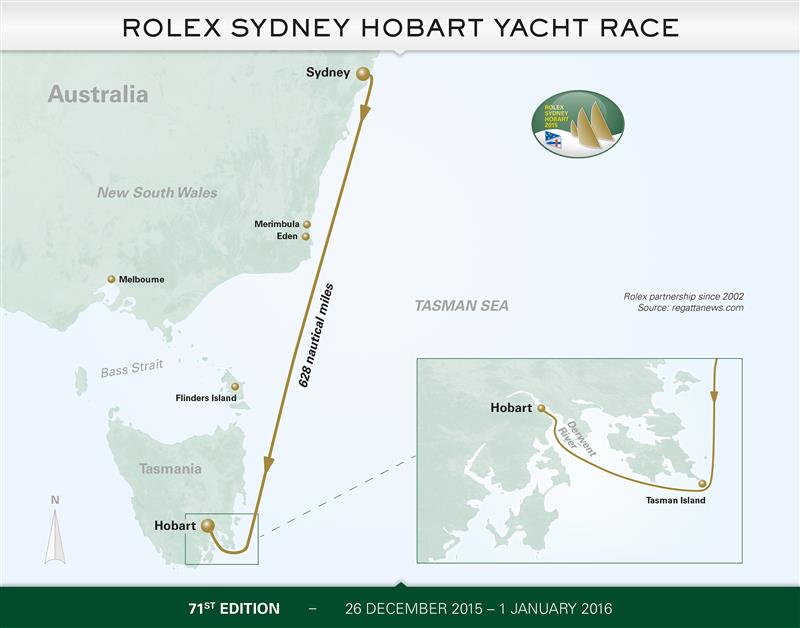
Tags: Sydney Hobart
Related Posts
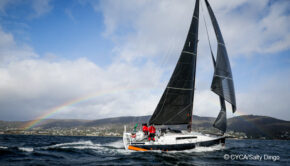
Double win for two-handed team in Sydney Hobart →
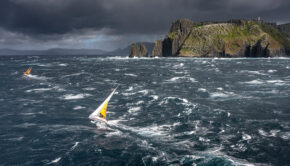
VIDEO: Sydney Hobart Race 2023 →
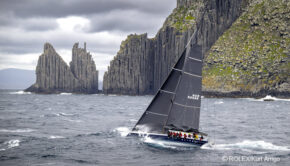
Alive claims overall Sydney Hobart title →
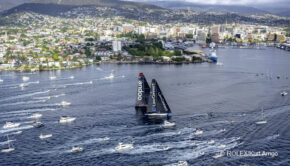
Victory to LawConnect in Sydney Hobart →
© 2024 Scuttlebutt Sailing News. Inbox Communications, Inc. All Rights Reserved. made by VSSL Agency .
- Privacy Statement
- Advertise With Us
Get Your Sailing News Fix!
Your download by email.
- Your Name...
- Your Email... *
- Phone This field is for validation purposes and should be left unchanged.

Sydney to Hobart 1998 tragedy 20 years on — the east coast low that changed marine forecasting
By Doyle Kate
ABC Weather
Topic: Weather
The 1998 Sydney to Hobart ended in disaster. On the Business Post Naiad yacht, two crew died. ( Supplied: Chris Timms )
As the yachts left Sydney Harbour on a sunny morning 20 years ago today, it would have been difficult to imagine the tragedy in store.
Strong winds were forecast and conditions worsened as the participants of the 1998 Sydney to Hobart set sail into what would become a severe east coast low.
In the ensuing days six sailors died, five yachts sank, more than 60 yachts retired and 55 participants had to be recued by helicopter.
East coast lows are unusual but not unprecedented. We typically see very intense east coast lows once every two or three years.
Dr Harald Richter, a senior research scientist at the Bureau of Meteorology, said east coast lows were big eddies in the atmosphere that were a few hundred kilometres across and occurred to the east of Australia.
They are not the same as more common lows that form over the Southern Ocean or lows that form over tropical waters.
"They're, in my mind, a mixture between lows that need cold air and warm air to spin up a big vortex and tropical cyclones.
"East coast lows sit in between those two," Dr Richter said.
The other factor that tends to make east coast lows infamous is that they impact on highly populated areas.
"Those east coast lows, when they're formed near the coast, don't go unnoticed. There's a lot of real estate to damage, there's boats to affect, there are beaches to erode," Dr Richter said.
"We need to look out for them."
In 1998, the biggest impacts were felt off the coast.
Jane Golding, manager of weather services at the Bureau of Meteorology's New South Wales office, said if there had been no yachts or ships in the area, the impact of the 1998 east coast low would have been a lot lower.
"It was really bad timing and really unfortunate it was in the middle of the yacht race [and] such a high profile one with so many participants," she said.
How the 1998 low developed
On Christmas Day 1998 there was a high pressure system directing warm north-easterly winds over south-east Australia and there was a cold front approaching Tasmania from the Southern Ocean.
Warm air from the Tasman Sea colliding with cold air from Antarctica caused the low to intensify rapidly. ( Supplied: Bureau of Meteorology )
"There were two things the high did, which is pretty common with east coast lows," Ms Golding said.
"It provided a warm, moist air as the front came up from the Southern Ocean carrying cold polar air.
"The difference in those two air masses resulted in the system really intensifying."
She said that the high pressure system also stopped the developing low from moving, so it hung around and just kept intensifying in the same area for about 24 hours.
"On top of that we also saw some high sea surface temperatures off the southern New South Wales coast."
She said that leading up to the race, the computer modelling that the forecasters were accessing was variable.
"They were looking at eight different computer models and they were all kind of saying different things," Ms Golding said.
"None of the ones we were accessing were pointing to the intensity of the storm.
"But that's similar to what could happen these days.
"With east coast lows, it's the closer you get to its formation that the guidance really starts to pinpoint intensity and location."
At the start of the race there was a gale warning out and a few hours later it was upgraded to storm-force. These warnings and how they were communicated were later investigated .
The east coast low developed on the morning of December 27 and moved through the strait during the day. ( Supplied: Bureau of Meteorology )
During the afternoon of December 26, 1998 the cold front approached eastern Bass Strait.
"The cold front had interacted with a trough just ahead of the front and that was the time where we saw this complex low pressure system start to form and several really small-scale features embed within it," Ms Golding said.
Not long after that, the east coast low rapidly intensified.
"That rapid development occurred because the really cold air coming up from the polar stream reached Tasmania," Ms Golding said.
"That really cold air interacted with this really warm air stream which was coming in from the Tasman Sea.
"On top of that there was some heat above and energy available from the warm ocean that was in the area at the time."
According to Ms Golding, it was the yachts that had reached as far as the Bass Strait and Tasmania on December 27, 1998 that faced the brunt of the storm.
By December 28, the low had moved quickly eastwards into the Tasman Sea and the winds had started to abate.
Twenty-four hours may not sound like long but it is a long time to be out at sea in a little boat being battered by winds equivalent to category two cyclone strength.
Ms Golding said wind gusts of 55 to 65 knots (roughly 100 to 120 kilometres per hour) were observed and gusts of between 70 to 75 knots (130 to 140 kph) were recorded — the equivalent of a category two cyclone. That is just what was recorded, gusts may have been stronger.
Waves recorded at the Esso Kingfish B Platform oil rig in Bass Strait during the 1998 Sydney to Hobart. ( Supplied: Bureau of Meteorology )
Ms Golding said there were a few little circulations among the bigger storm, so there was a tiny easing for a short period on December 27, 1998 before the winds increased again.
"The wind whipped up really high seas. The waves were quite steep and there was a strong southerly current," she said.
"What we call the significant wave height was six to seven metres and you get higher waves and smaller waves in there.
"The highest recorded on this oil rig was 11 to 12 metres but there were reports from ships that were even higher than that.
"There were reports of waves up in the 10 to 15m range, which is a few storeys if you're looking at a building.
"Imagine those waves [being] quite steep, then the yachts were quite small comparably. [It was] a really tragic event being stuck in that," Ms Golding said.
On top of the wind and the waves there was also a thunderstorm with heavy rain and very low visibility.
Which is worse: storm or gale?
Gusts of up to 64 knots, or 119kph, were recorded at the Esso Kingfish oil rig in Bass Strait. ( Supplied: Bureau of Meteorology )
The feedback from the investigations following the race were less about problems with the forecast itself and more about the communication pathways and the terminology used.
"A key take-home message is the terminology that we used wasn't well understood," Ms Golding said.
"Which meant that when the forecast warnings were upgraded they may not have been heeded because of the terminology we were using."
The key example from 1998 is that a "storm-force warning" means that winds averaging 48 to 63 knots (89 to 117kph) should be expected, which is worse than a "gale warning" and can mean that you should expect gusts to be higher.
"We know that is a category two tropical cyclone strength, but should we assume that everyone does? No."
Lessons learnt
Now the race has a more comprehensive safety briefing.
"We go through the terminology," Ms Golding said.
"We provide some info. around that, some definitions around the terms that we use, [and we do] other things like we are forecasting the mean speed so you can expect gusts higher than this.
"It won't be written on the forecast because there is a limit to how many words you can use before it's overwhelming.
"We also include a preamble at the header of all of our coastal waters forecasts even outside this race."
There are many other things that have changed in the past 20 years.
Ms Golding said the communication pathways between the Bureau and race organisers were now stronger and better defined.
"Technology today compared with technology 20 years ago, it's completely different. It's easier to transmit data to folks offshore in yachts. It's easier for them to receive not just our data but other data and to be more contactable as well," she said.
"On top of that the computer modelling has improved dramatically in the last 20 years, which means we are starting off at a better place."
Could we see 1998 conditions again?
Ms Golding said that we could "absolutely" see a storm like 1998 affect the Sydney to Hobart yacht race again.
"I don't want to say it's unlikely because it's no less likely to form on December 26 and 27 than December 22 or 23 or January 30 or 31."
But she said it was unusual and there had not been one like it during the Sydney to Hobart since.
What the race does see more often is a 'southerly buster': a sudden and powerful southerly wind change.
"Normally [you] get pretty fresh northerlies ahead of it and then your southerly buster could have 50-60 knot gusts," Ms Golding said.
"The difference with your buster is it's a lot shorter lived."
This year's forecast
This year the forecast is for a quick start to the race as a high sits in the western Tasman Sea and a trough over inland New South Wales, directing northerly winds down the coast.
In the pre-race press conference on Friday there was still some uncertainty about how the trough and a front could impact the later part of the race, but the Bureau's spokesman Simon Lewis said there was no indication of a significant low pressure system developing during the race.
Other east coast lows
Pasha Bulker 2007: it was the morning Newcastle will never forget. As the sun hit the shore, locals woke up to find a massive coal ship right on the beach . The June storm resulted in nine deaths on the New South Wales central coast. The ship was pummelled by the waves for three weeks before it was finally refloated in a salvage operation that cost the Japanese owners $1.8 million.
The Pasha Bulker ran aground off Nobbys Beach, Newcastle, on June 8, 2007. ( ABC TV )
- April 2015: three people died when an east coast low battered Sydney, the Hunter and the Central Coast. At the time, the Bureau said gusts got up to 135kph but Dr Richter said the main impact from the storm was the flooding. In a 24 hour period, 119mm was recorded on Sydney Observatory Hill.
- June 2016: this storm is best remembered for th e images of a swimming pool falling into the ocean. Five people died during the storm, which brought heavy rainfall and caused coastal erosion. Impacts were felt from Queensland to Tasmania.
The Shortwave Radio Audio Archive

The Archive
Sydney to hobart yacht race hf recording: december 28, 1998.

Many thanks to SRAA contributor, Neil Howard, for sharing the following recording and notes:
The Sydney to Hobart Yacht race of 1998 was tragic as huge seas & storms decimated the fleet, leaving 6 people dead and 5 boats sunk.
HOW this was obtained
This recording of the SSB HF transmissions from 1998 was recorded by me from Queensland, using a newfangled unattended recoding program on the PC and a very ordinary Sangean ATS-803a receiver using a random long wire Antenna - from memory this was on the 8 Mhz Marine band, and is the co-ordination of the search and rescue from the 28th Dec 1998 and covers from around 8:30PM till 10PM - The automated recorded stopped recording when the signal noise dropped below a certain level and thus some was lost. The recording goes for 30 mins, as that was the limit that was set to save disk space, but there is a lot of empty noise.
I present this recording as it was recorded, warts and all for your education *** I dedicate this to those lost at sea ****
HIGHLIGHTS (Times are approximate) 4:11 "Rescue 253" 9A helicopter) locates a life-raft 6:00 "Air force Sydney" is looking for a position of a yacht " Solo Global Challenge" 6:50 "RCC Canberra" (Who is co-ordinating) has a "hot mic" and is explaining the situation to someone locally 8:35 "Rescue 253" has sighted 2 POB on the life-raft - RTC wants to know if they are from "Winston Churchill" 9:39 Another "hot mic" in Canberra 11:56 "Tiger75" (A Navy Helicopter, I think) has the survivors on board, but still awaiting info on who they are 13:04 13:44 confirmation that there are 2 survivors of the "Winston Churchill" from the life raft, but the tragic news that 3 others had "rolled out" of the raft and are lost (Historical note- these three were listed as drowned) 14:46 Discussion about where the survivors are to be taken by Tiger 75 15:20 Info of the survivors is passed though, along with the news that the life raft they were "in" had no bottom. 16:33 Rescue 253 Says it has heard a beacon & is proceeding to the location 20:00 Another aircraft has gone to the search site from Merimbula (A town in New South Wales) 25:38 Rescue 253 updates beacon location 26;30 Rescue 253 Locates a boat at the beacon site that has been dis-masted & is in serious trouble.
The Shortwave Radio Audio Archive (SRAA) is a collection of shortwave radio recordings that you can download or listen to as a podcast . The collection grows every day and includes both historic recordings and current recordings from the shortwave radio spectrum.
The goal of this site is for shortwave radio enthusiast to have a place to store, archive and share their radio recordings with the world.
Click here to learn how to contribute and archive recordings .

Subscribe to the archive on iTunes,
You can subscribe to the archive with any podcasting application by subscribing to our RSS feed. Simply right click and copy this RSS feed url , then paste it into your podcasting application's subscribe box.
- August 2024 4
- July 2024 4
- June 2024 4
- April 2024 4
- March 2024 5
- February 2024 4
- January 2024 5
- December 2023 7
- November 2023 3
- October 2023 4
- September 2023 4
- August 2023 8
- July 2023 6
- June 2023 5
- April 2023 5
- March 2023 6
- February 2023 8
- January 2023 6
- December 2022 9
- November 2022 7
- October 2022 3
- September 2022 9
- August 2022 5
- July 2022 4
- June 2022 7
- April 2022 6
- March 2022 9
- February 2022 27
- January 2022 3
- December 2021 9
- November 2021 22
- October 2021 9
- September 2021 3
- August 2021 5
- July 2021 2
- June 2021 3
- April 2021 1
- March 2021 4
- February 2021 7
- January 2021 11
- December 2020 11
- November 2020 3
- October 2020 7
- September 2020 11
- August 2020 9
- July 2020 13
- June 2020 8
- May 2020 33
- April 2020 5
- March 2020 6
- February 2020 1
- January 2020 6
- December 2019 6
- November 2019 4
- October 2019 2
- September 2019 3
- August 2019 6
- July 2019 7
- June 2019 4
- April 2019 6
- March 2019 7
- February 2019 8
- January 2019 5
- December 2018 10
- November 2018 10
- October 2018 6
- September 2018 3
- August 2018 8
- July 2018 4
- June 2018 6
- April 2018 5
- March 2018 7
- February 2018 8
- January 2018 17
- December 2017 8
- November 2017 4
- October 2017 11
- September 2017 14
- August 2017 5
- July 2017 3
- June 2017 4
- May 2017 12
- April 2017 3
- March 2017 3
- February 2017 9
- January 2017 2
- December 2016 22
- November 2016 30
- October 2016 20
- September 2016 6
- August 2016 6
- July 2016 14
- June 2016 31
- May 2016 21
- April 2016 19
- March 2016 20
- February 2016 28
- January 2016 37
- December 2015 20
- November 2015 11
- October 2015 20
- September 2015 36
- August 2015 4
- July 2015 21
- June 2015 11
- April 2015 7
- March 2015 18
- February 2015 24
- January 2015 25
- December 2014 6
- November 2014 58
- October 2014 20
- September 2014 6
- August 2014 13
- July 2014 26
- June 2014 14
- May 2014 13
- April 2014 25
- March 2014 12
- February 2014 30
- January 2014 14
- December 2013 12
- November 2013 12
- October 2013 14
- September 2013 11
- August 2013 7
- June 2013 8
- April 2013 12
- March 2013 16
- February 2013 19
- January 2013 14
- December 2012 9
- November 2012 2
- October 2012 4
- September 2012 5
- August 2012 7
- July 2012 3
- June 2012 4
- April 2012 2
- January 2012 2
- December 2011 1
- August 2024
- February 2024
- January 2024
- December 2023
- November 2023
- October 2023
- September 2023
- August 2023
- February 2023
- January 2023
- December 2022
- November 2022
- October 2022
- September 2022
- August 2022
- February 2022
- January 2022
- December 2021
- November 2021
- October 2021
- September 2021
- August 2021
- February 2021
- January 2021
- December 2020
- November 2020
- October 2020
- September 2020
- August 2020
- February 2020
- January 2020
- December 2019
- November 2019
- October 2019
- September 2019
- August 2019
- February 2019
- January 2019
- December 2018
- November 2018
- October 2018
- September 2018
- August 2018
- February 2018
- January 2018
- December 2017
- November 2017
- October 2017
- September 2017
- August 2017
- February 2017
- January 2017
- December 2016
- November 2016
- October 2016
- September 2016
- August 2016
- February 2016
- January 2016
- December 2015
- November 2015
- October 2015
- September 2015
- August 2015
- February 2015
- January 2015
- December 2014
- November 2014
- October 2014
- September 2014
- August 2014
- February 2014
- January 2014
- December 2013
- November 2013
- October 2013
- September 2013
- August 2013
- February 2013
- January 2013
- December 2012
- November 2012
- October 2012
- September 2012
- August 2012
- January 2012
- December 2011
- Broadcasters
- Clandestine
- Digital Modes
- Final Broadcasts
- First broadcasts
- In the Press
- Inaugural Broadcasts
- Internet Audio
- Interval Signals
- Natural Disasters
- Numbers Stations
- Pirate Radio
- Radio History
- Radio Plays
- Religious Broadcasters
- Shortwave Radio
- Station IDs
- Studio Recordings
- Test Transmissions
- Time Signal Stations
- Utility Stations
- Nautic Shows
- Amerisca’s Cup
- Classic Yachts
- Motor Yachts
- Sailing Yachts
- Superyachts
- Yacht Clubs
Emirates Team New Zealand Team Story
Nyyc american magic team story, emirates team new zealand vs. luna rossa prada pirelli – full race replay, louis vuitton preliminary regatta – barcelona | day 4 – live, superyachts and the super rich – full episode 2024, k1 britannia’s story – the kings yacht, oceanslab – race to zero emissions, riva 76′ bahamas super, the perfect balance – ferretti group, rafa nadal captains a team in the e1, the formula 1 of the sea, “mayhem at lake george” annual boating event lives up to the name, candela c-8 flying above the waves, brabus shadow 900 | 300nm (550km) offshore in 9.5 hours , emirates team new zealand launched their prototype hydrogen-powered foiling chase boat in auckland today, the sailing sixties bbc documentary, j class yacht revival, 44cup calero marinas 2024 review, recap – j class world championship 2017, sailing 60 knots wind on a swan 57, basque country international jet ski cup 2024, fuerteventura kitefoil international open cup 2024, patri mclaughlin sets new kitesurfing world record 72ft at jaws, sp80 – the boat designed to break the world sailing record, the sydney to hobart yacht race 1998: remembering a deadly storm, the fastnet yacht race tragedy of 1979, tracy edwards – maiden round the world skipper, joshua slocum: the mysterious disappearance of a sea pioneer/ full documentary, baltimore: ‘mass casualty event’ as bridge collapses after being hit by ship.
- Nautic Life
To mark the 20th anniversary of the deadly 1998 Sydney to Hobart Yacht Race, Four Corners unearthed this archive episode investigating what happened in that fateful event. Six sailors died and five boats were lost when a terrifying storm hit Bass Strait during the 1998 Sydney to Hobart yacht race. Look back at this investigation by Debbie Whitmont, that retraces the horrific events that unfolded why it was so unexpected.

RELATED ARTICLES MORE FROM AUTHOR
Rescue and salvage operation in the azores.
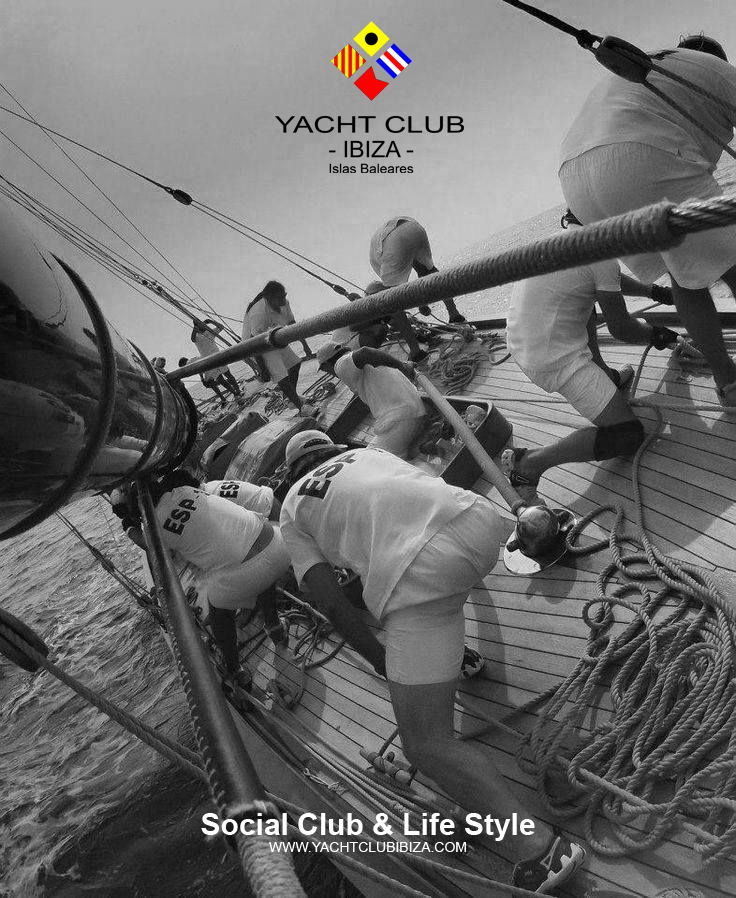
RECOMMENDED VIDEOS
Emirates team new zealand vs. luna rossa prada pirelli – full..., ineos britannia team story, editor picks, popular posts, louis vuitton preliminary regatta – barcelona | day 1 – live, sailgp christchurch bids farewell: coutts cites ‘minority groups’ as cause for..., catamaran vs. monohull | the controversy of the 1988 americas cup, popular category.
- Amerisca's Cup 75
- Tripulante 18 28
- Motor Yachts 3
- Sailing Yachts 3
- Superyachts 3
- Nautic Magazine
- Advertising
- Knowledge Hub
- Education for Young People

Sydney to Hobart yacht race, 1998
Quick statistics.
Shortly after the commencement of the annual Sydney to Hobart Yacht Race, a 'super cell' storm stirred up massive seas in the Bass Strait. The storm cut through the fleet, resulting in the drowning of six sailors (from New South Wales, Tasmania and Britain).
Seven yachts were abandoned at sea and lost. Thirty civil and military aircraft took part in the rescue operation of 55 sailors from 12 impacted yachts. Only 44 of 115 yachts finished the race; many retired from the event, seeking refuge at Eden on the southern New South Wales coast.
The total cost, including damaged and sunken boats, plus the rescue bill, was estimated at $30 million.
The Australian, ‘Sydney to Hobart 2008 [retrospective]’, website viewed Feb 16, 2015 Bureau of Meteorology, Preliminary Report on Meteorological Aspects of the 1998 Sydney to Hobart Yacht Race, February 1999, website viewed 17 February 2015 New South Wales State Coroner, State Coroner’s Inquest 1998 Sydney to Hobart Yacht Race, 2001, website viewed 17 February 2015
We’re fighting to restore access to 500,000+ books in court this week. Join us!
Internet Archive Audio

- This Just In
- Grateful Dead
- Old Time Radio
- 78 RPMs and Cylinder Recordings
- Audio Books & Poetry
- Computers, Technology and Science
- Music, Arts & Culture
- News & Public Affairs
- Spirituality & Religion
- Radio News Archive

- Flickr Commons
- Occupy Wall Street Flickr
- NASA Images
- Solar System Collection
- Ames Research Center

- All Software
- Old School Emulation
- MS-DOS Games
- Historical Software
- Classic PC Games
- Software Library
- Kodi Archive and Support File
- Vintage Software
- CD-ROM Software
- CD-ROM Software Library
- Software Sites
- Tucows Software Library
- Shareware CD-ROMs
- Software Capsules Compilation
- CD-ROM Images
- ZX Spectrum
- DOOM Level CD

- Smithsonian Libraries
- FEDLINK (US)
- Lincoln Collection
- American Libraries
- Canadian Libraries
- Universal Library
- Project Gutenberg
- Children's Library
- Biodiversity Heritage Library
- Books by Language
- Additional Collections

- Prelinger Archives
- Democracy Now!
- Occupy Wall Street
- TV NSA Clip Library
- Animation & Cartoons
- Arts & Music
- Computers & Technology
- Cultural & Academic Films
- Ephemeral Films
- Sports Videos
- Videogame Videos
- Youth Media
Search the history of over 866 billion web pages on the Internet.
Mobile Apps
- Wayback Machine (iOS)
- Wayback Machine (Android)
Browser Extensions
Archive-it subscription.
- Explore the Collections
- Build Collections
Save Page Now
Capture a web page as it appears now for use as a trusted citation in the future.
Please enter a valid web address
- Donate Donate icon An illustration of a heart shape
Sydney To Hobart Yacht Race HF Recording: December 28, 1998
Audio with external links item preview.

Share or Embed This Item
Flag this item for.
- Graphic Violence
- Explicit Sexual Content
- Hate Speech
- Misinformation/Disinformation
- Marketing/Phishing/Advertising
- Misleading/Inaccurate/Missing Metadata

Many thanks to SRAA contributor, Neil Howard, for sharing the following recording and notes:
The Sydney to Hobart Yacht race of 1998 was tragic as huge seas & storms decimated the fleet, leaving 6 people dead and 5 boats sunk.
HOW this was obtained
This recording of the SSB HF transmissions from 1998 was recorded by me from Queensland, using a newfangled unattended recoding program on the PC and a very ordinary Sangean ATS-803a receiver using a random long wire Antenna - from memory this was on the 8 Mhz Marine band, and is the co-ordination of the search and rescue from the 28th Dec 1998 and covers from around 8:30PM till 10PM - The automated recorded stopped recording when the signal noise dropped below a certain level and thus some was lost. The recording goes for 30 mins, as that was the limit that was set to save disk space, but there is a lot of empty noise.
I present this recording as it was recorded, warts and all for your education *** I dedicate this to those lost at sea ****
HIGHLIGHTS (Times are approximate) 4:11 "Rescue 253" 9A helicopter) locates a life-raft 6:00 "Air force Sydney" is looking for a position of a yacht " Solo Global Challenge" 6:50 "RCC Canberra" (Who is co-ordinating) has a "hot mic" and is explaining the situation to someone locally 8:35 "Rescue 253" has sighted 2 POB on the life-raft - RTC wants to know if they are from "Winston Churchill" 9:39 Another "hot mic" in Canberra 11:56 "Tiger75" (A Navy Helicopter, I think) has the survivors on board, but still awaiting info on who they are 13:04 13:44 confirmation that there are 2 survivors of the "Winston Churchill" from the life raft, but the tragic news that 3 others had "rolled out" of the raft and are lost (Historical note- these three were listed as drowned) 14:46 Discussion about where the survivors are to be taken by Tiger 75 15:20 Info of the survivors is passed though, along with the news that the life raft they were "in" had no bottom. 16:33 Rescue 253 Says it has heard a beacon & is proceeding to the location 20:00 Another aircraft has gone to the search site from Merimbula (A town in New South Wales) 25:38 Rescue 253 updates beacon location 26;30 Rescue 253 Locates a boat at the beacon site that has been dis-masted & is in serious trouble.
plus-circle Add Review comment Reviews
Download options, in collections.
Uploaded by K6KJN on May 16, 2023
SIMILAR ITEMS (based on metadata)
- Share full article
Advertisement
Supported by
1998 Tragedy Haunts Sydney-Hobart Race
By Christopher Clarey
- Dec. 24, 2008
Silence is hard to come by in the annual Sydney-to-Hobart race. There is the drone or the shriek of the wind, the crash of the waves against the hulls, the ominous harmonics of equipment under great stress, and the shouts and mutters from the crews as they try, once again, to sail their yachts of various shapes and prices from the majesty of Sydney Harbor to the haven of Hobart across the Tasman Sea.
But when this year’s race begins on Friday, silence will be a requirement. It has been 10 years since six men died in the storm-swept 1998 edition of this Australian institution, and a minute of silence before the start and another after the finish will honor those sailors as well as others who perished in the race in earlier years.
“I think it is an appropriate way to show our respects to those who didn’t make it; I’m not sure if there’s any other better way to do it,” said Ed Psaltis, who was skipper of the small yacht that won overall honors in 1998 despite the horrific conditions that some ashen competitors compared to a hurricane.
A single wreath will also be laid in Hobart by Matt Allen, commodore of the Cruising Yacht Club of Australia, which organizes the race, and Clive Simpson, his counterpart at the Royal Yacht Club of Tasmania. Allen and other club officials have contacted the families of the sailors who died in 1998 and received tentative commitments from some family members to be in attendance in Hobart.
“What happened is part of the history of the race you can’t deny it,” Psaltis said. “One of the guys who died in 1998, Jim Lawler, was a very close friend of my father’s, so it was a personal thing for me.”
He added: “And he was no average yachtie. He was a very accomplished seaman, so to have him perish really knocked me for six. It just showed that even if you are among the best, you can still get taken out. What it shows you, above all, is that the sea is the boss, and you are its servant and don’t even try to think otherwise.”
Larry Ellison, the American billionaire who took line honors in that 1998 race in his maxi Sayonara, gleaned enough amid the 80-knot winds and 60-foot waves to conclude that he never wanted to race the 628 nautical miles from Sydney to Hobart again.
He has been true to his word. He has since focused his big sailing ambitions and budgets on the America’s Cup and other inshore regattas.
But Australians like Psaltis have a more elemental connection to their island nation’s premier yacht race, which was first contested in 1945, just months after the end of World War II. Psaltis, 47, like many a Sydney-to-Hobart skipper, has a regular job that has nothing to do with sailing: He is a partner in Sydney with the accounting firm of Ernst & Young.
Yet despite the torments of 1998 and of other stormy, hazardous years, he has continued to put himself on the starting line. This will be his 28th Sydney-Hobart race, and the 10-member crew on his modified Farr 40, still named Midnight Rambler, will include three other men who sailed with him in 1998: Chris Rockell, John Whitfeld and Bob Thomas, Psaltis’s co-owner and longtime navigator.
“Look, after 1998 I certainly thought very hard about it postrace, along the lines of: I’ve got a wife and three kids. What am I trying to do, to try and kill myself in a stupid yacht race?” Psaltis said. “But I firmly believe that the human spirit wants challenges and actually craves challenges, and to go through life controlled in a regimented, risk-free environment is, I think, no life at all.”
The Hobart as its participants often call it is, however, a more regimented race than it was 10 years ago. Safety requirements have been significantly increased and, as with all offshore races, safety equipment has improved. More of it has been made compulsory, including Emergency Position Indicating Radio Beacons.
At least 50 percent of each crew must take a course on safety at sea, and 50 percent must have completed a Category 1 ocean race. Sailors under 18 are no longer permitted to take part. The Australian authorities have revised and upgraded their contingency plans for rescue and emergency situations.
“The truth is, 1998 was the biggest maritime rescue operation in the history of Australia,” Allen said. “So I think it’s made people focus.”
He added: “You don’t have, as I’ve seen in some other races around the world, people getting together for one race of the year. Pretty much most of the crews in the Sydney Hobart are people racing pretty much continuously.”
The emphasis on safety has increased costs.
“It probably costs about 60,000 Australian dollars to get the average boat trumped up to do the race,” Psaltis said, or about $41,000. “In 1998, it was 30,000 to 40,000. The cost of sails has gone up. Everything has gone up. But safety is one more issue making it harder.”
The surprise is that the new regulations and the global economic downturn have not affected participation rates. Although there have been some high-profile withdrawals, including a Russian maxi called Trading Network, the fleet of 104 yachts for the race this year is the second-highest number of entrants since 1998.
“I think it’s because people have built boats a while ago or ordered boats a while ago, and that’s probably a reflection of earlier economic times,” Allen said. “People have boats, and they might as well go sailing in them.”
Among those who plan to sail is John Walker, who was already the oldest skipper in the race’s history and is now 86. Rob Fisher and Sally Smith, the children of an avid Sydney-Hobart competitor, will become the first brother and sister to skipper yachts in the race in the same year.
Wild Oats XI, the 98-foot maxi owned by the Australian Bob Oatley, has taken line honors the last three years and is a heavy favorite to become the first yacht to do it four consecutive times. Its crew had to scramble to make final-hour repairs last year, but there have been no such dramas in the run-up to this year’s race.
“These boats are clearly faster than any other boats,” Allen said of the maxis. “It’s more a boat-management issue and seamanship issue for them, and absolutely, to get it there four times in a row unscathed would be a great tribute to the skills of the crew.”
But then, Wild Oats XI has never had to sail through what Ellison and Psaltis endured in 1998.
“We got through it, but only through the skin of our teeth,” Psaltis said. “For 10 hours, we were surviving rather than racing. It was the worst I’ve seen and something I don’t want to see again. It certainly did change our lives.”
- SYDNEY, NSW
- MELBOURNE, VIC
- HOBART, TAS
- BRISBANE, QLD
- ADELAIDE, SA
- CANBERRA, ACT
- Watch the US Open for free on 9Now
Sydney to Hobart tragedy: Heroes, survivors reflect

- A Current Affair
- SYDNEY TO HOBART
Send your stories to [email protected]
Auto news: You can still buy a non-hybrid Toyota Camry, there's just one big catch.
Top Stories

Lorraine Lea Linen collapses into administration after almost 40 years

'Pizza bomber's' bank heist goes horribly wrong

Thousands are watching livestream of falcon on Melbourne rooftop

Police hunt man after baby attacked with coffee in Brisbane park

- AMERICA'S CUP
- CLASSIFIEDS
- NEWSLETTERS
- SUBMIT NEWS
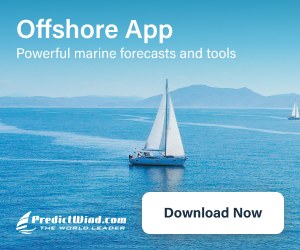
1998 Sydney Hobart Yacht Race Remembered
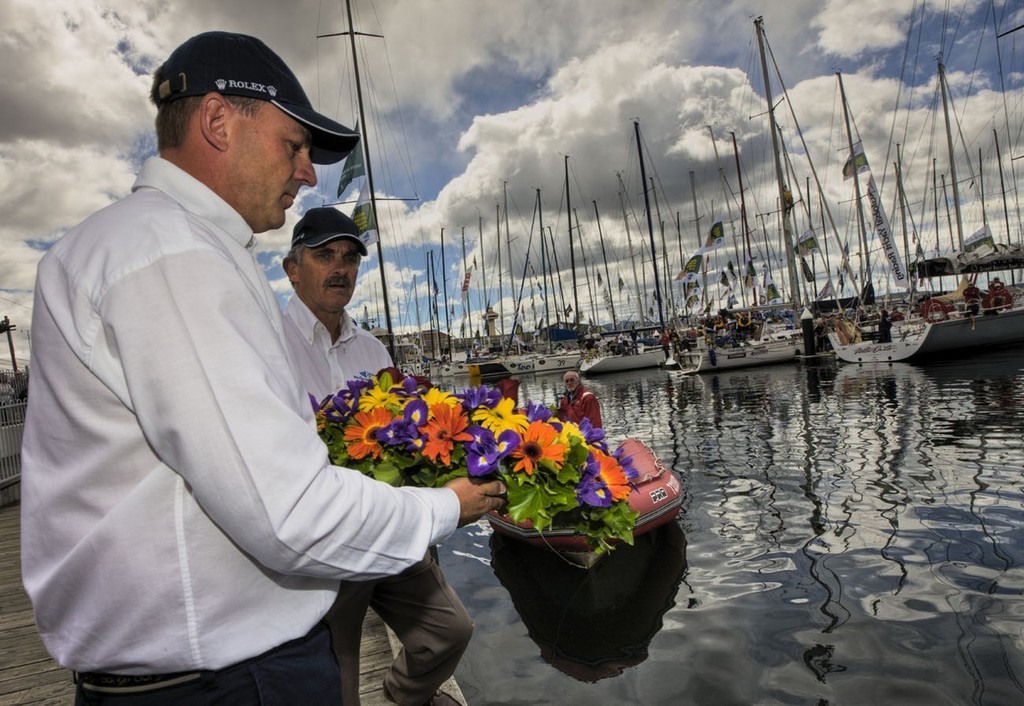
Related Articles
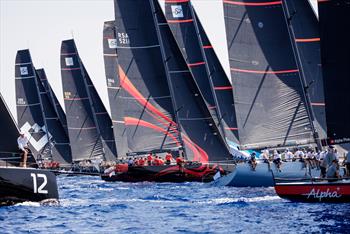

IMAGES
COMMENTS
One of the world's three great ocean sailing competitions, the annual 630-mile race from Sydney, Australia, to Hobart, Tasmania, pits sailboats against the n...
An unusually strong low pressure depression developed which resulted in mid-summer snow across parts of south-east Australia. The weather system built into a...
To mark the 20th anniversary of the deadly 1998 Sydney to Hobart Yacht Race, Four Corners unearthed this archive episode investigating what happened in that ...
The 1998 Sydney to Hobart Yacht Race was the 54th annual running of the "blue water classic" Sydney to Hobart Yacht Race. It was hosted by the Cruising Yacht Club of Australia based in Sydney, New South Wales. It was the most disastrous in the race's history, with the loss of six lives and five yachts. [ 1] 55 sailors were rescued in the ...
Along with the 1979 Fastnet Race, the 1998 Sydney Hobart has become a byword for disaster at sea.Unless a writer was actually on board one of the boats and recounts personal experience, reporting ...
Video. An illustration of an audio speaker. Audio. An illustration of a 3.5" floppy disk. Software An illustration of two photographs. ... The Sydney to Hobart Yacht race of 1998 was tragic as huge seas & storms decimated the fleet, leaving 6 people dead and 5 boats sunk. *** HOW this was obtained ***
VIDEO: Sydney Hobart Yacht Race 1998. As the 71st edition of the Sydney Hobart Yacht Race prepares to start on December 26, a weather forecast for strong winds brings back memories from one of the ...
Sydney to Hobart 1998 tragedy 20 years on — the east coast low that changed marine forecasting. ... "It was really bad timing and really unfortunate it was in the middle of the yacht race [and ...
Many thanks to SRAA contributor, Neil Howard, for sharing the following recording and notes: The Sydney to Hobart Yacht race of 1998 was tragic as huge seas & storms decimated the fleet, leaving 6 people dead and 5 boats sunk. HOW this was obtained. This recording of the SSB HF transmissions from 1998 was recorded by me from Queensland, using a ...
The start of the race, Boxing Day 1998. Simon Alekna. A fateful decision by five shipwrecked Sydney-Hobart yachtsmen to cut an air hole in the floor of their overturned life raft ended in three of ...
Richard Bennett's exclusive coverage of the 1998 Sydney Hobart yacht race storm were published around the world From ' Life' magazine to 'Paris Match .'They ...
To mark the 20th anniversary of the deadly 1998 Sydney to Hobart Yacht Race, Four Corners unearthed this archive episode investigating what happened in that fateful event. Six sailors died and five boats were lost when a terrifying storm hit Bass Strait during the 1998 Sydney to Hobart yacht race. Look back at this investigation by Debbie ...
70 Injured. $5 million Insurance Costs. Shortly after the commencement of the annual Sydney to Hobart Yacht Race, a 'super cell' storm stirred up massive seas in the Bass Strait. The storm cut through the fleet, resulting in the drowning of six sailors (from New South Wales, Tasmania and Britain). Seven yachts were abandoned at sea and lost.
Boxing Day dawned hot but clear over the mainland harbour city for the start of the 1998 Sydney to Hobart race. The nor'east sea breeze was building and most sailors on the 115 competing yachts ...
Video. An illustration of an audio speaker. Audio. An illustration of a 3.5" floppy disk. Software An illustration of two photographs. ... The Sydney to Hobart Yacht race of 1998 was tragic as huge seas & storms decimated the fleet, leaving 6 people dead and 5 boats sunk. HOW this was obtained
In 1998, David Key of the Victorian Police's air wing became the designated Tea Bag aboard a rescue helicopter roaring towards Bass Strait and an unfolding disaster in the Sydney to Hobart Yacht Race.
Pretty much most of the crews in the Sydney Hobart are people racing pretty much continuously.". The emphasis on safety has increased costs. "It probably costs about 60,000 Australian dollars ...
About Press Copyright Contact us Creators Advertise Developers Terms Privacy Policy & Safety How YouTube works Test new features NFL Sunday Ticket Press Copyright ...
The 1998 Sydney to Hobart will go down as one of Australia worst maritime tragedies. Davidson was dangled out of a helicopter to lift stranded crew from the ocean. (A Current Affair) In total ...
Posted today at 5:03 am GCCM Gold Coast Mackay Yacht Race overall The final boat to finish the race and dock, 'She' crossed the line at 1409 hrs on Day 4 The final boat to finish the race and dock, 'She' crossed the line at 1409 hrs on Day 4, some 76 hours and 9 minutes after the start line off Cavill Avenue.
The 1998 Sydney-to-Hobart Yacht race was the deadliest in Australian sailing history. On the 20th anniversary we pause to remember the six sailors who lost their lives. We give thanks to the many rescues teams including the Vic Pol Helicopter which was piloted by Darryl Jones who sits on our Foundations Board.
The Sydney to Hobart Yacht race of 1998 was tragic as huge seas & storms decimated the fleet, leaving 6 people dead and 5 boats sunk.*** HOW this was obtaine...
In The Proving Ground, journalist and lifelong sailor G. Bruce Knecht tells the staggering story of the 54th Sydney to Hobart yacht race--an annual event that is always an extreme test of courage and skill in some of the world's most treacherous seas, but which in 1998 would become the most disastrous race in modern yachting history.. Although he was already fifty feet from the boat, Brownie ...